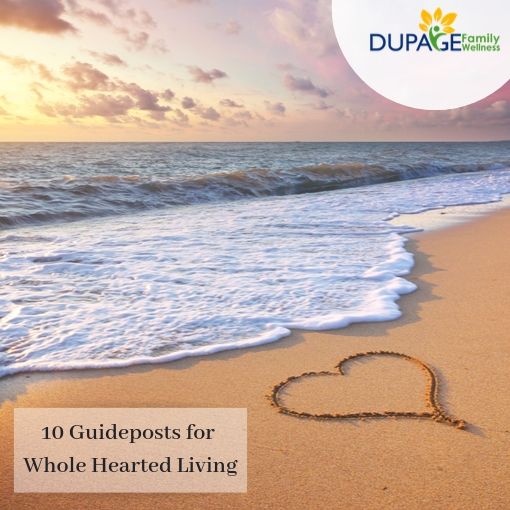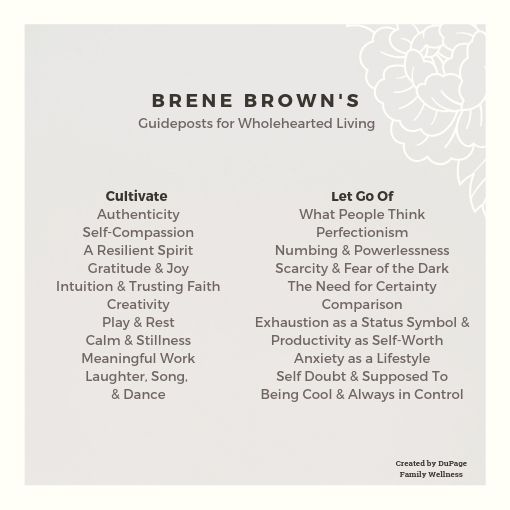
“Wholeheartedness is like a North Star. You can never get there, but you know when you are headed the right way.” - Brene Brown
Brene Brown is a researcher and social worker best known for her work on shame, vulnerability, and living a wholehearted life. She is a compelling storyteller which allows her to communicate deep concepts in an accessible and enjoyable way.
In her book Daring Greatly: How the Courage to Be Vulnerable Transforms the Way We Live, Love, Parent, and Lead she explores 10 guideposts to living wholeheartedly.
Brown says, “wholehearted living is about engaging in our lives from a place of worthiness. It means cultivating the courage, compassion, and connection to wake up in the morning and think - no matter what gets done and how much is left undone, I am enough! It’s going to bed at night thinking; yes, I am imperfect and vulnerable and sometimes afraid, but that doesn’t change the fact that I am also brave and worthy of love and belonging. Wholehearted living is not a one-time choice; it is a process. In fact, I believe it’s the journey of a lifetime.”
Cultivating the Positive
Brown created the 10 Guideposts for Wholehearted Living based on her research of people she describes as living a wholehearted life. Each guidepost has something positive to cultivate as well as something that must be released. As the term guidepost implies, the goal is to be heading in the right direction, not achieving some level of perfection.
This week we will look into cultivating the positive aspects of living a wholehearted life and next week we will focus on things we must release. Intentionally developing practices around these principles will lead you towards embracing a more wholehearted way of living. (For a sneak peak of what we need to let go of look at the graphic below).

• Authenticity
Brown says, “Authenticity is the daily practice of letting go of who we think we’re supposed to be, and embracing who we actually are.”
• Self-Compassion
According to mindfulness and self-compassion expert Kristen Neff, self compassion includes self-kindness, an awareness of our common humanity, and practicing mindfulness. (For great resources on self-compassion check out Neff’s website.)
• A Resilient Spirit
Resilience has to do with a “tolerance for discomfort.” We must be able to do tough things, go through tough situations, and feel tough emotions.
• Gratitude & Joy
Brown found that the most joyful people developed a gratitude practice. (Check out this blog post for more about Authentic Gratitude in Difficult Times.)
• Intuition & Trusting Faith
As Brown says, “Intuition is not a single way of knowing…it’s our ability to hold space for uncertainty and our willingness to trust the many ways we have developed knowledge and insight, including instinct, experience, faith, and reason.”
• Creativity
According to Brown, “There’s no such thing as creative people and non-creative people. There are only people who use their creativity and people who don’t. Unused creativity doesn’t just disappear. It lives within us until it’s expressed, neglected to death, or suffocated by resentment and fear.”
• Play & Rest
Dr. Stuart Brown, who leads the National Institute for Play, states “play shapes our brain, helps us foster empathy, helps us navigate complex social groups, and is at the core of creativity and innovation.”
• Calm & Stillness
Brene Brown defines calm as “creating perspective and mindfulness while managing emotional reactivity.”
• Meaningful Work
Mike Robbins author of Bring Your Whole Self to Work says, “to truly succeed in today’s business world, we must be willing to bring our whole selves to the work that we do. This means showing up authentically, leading with humility, and remembering that we’re all vulnerable, imperfect human beings doing the best we can. It’s also about having the courage to take risks, speak up, ask for help, and connect with others in a genuine way, allowing ourselves to be seen.” (He offers five tips for doing this in his article on the subject.)
• Laughter, Song, and Dance
Brown explains that “Laughter, song, and dance create emotional and spiritual connection; they remind us of the one thing that truly matters when we are searching for comfort, celebration, inspiration or healing: We are not alone.”
While inspiring, these concepts are not always easy to implement. It takes courage to move towards this way of living, since these concepts require embracing vulnerability. Everyone must decide for themselves if the benefits are worth the risks. For myself, I tend to believe Brown when she declares, “wholeheartedness is hard. But not fully living our lives is much harder. And much more dangerous.”
Dr. Jamie
